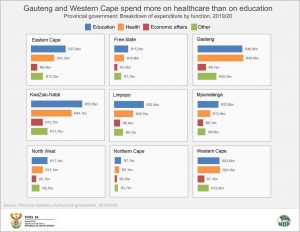Healthcare and education spending: GP and WC the odd ones out
Provincial government plays a vital role in the administration of the country’s health and education systems, responsible for providing basic education to learners and healthcare to those in need.
These two mammoth tasks take up the bulk of provincial government spending. In the 2019/20 fiscal year, total provincial government expenditure was R628,8 billion. Education was the biggest expenditure item, accounting for 41% (R260,7 billion) of this amount. Healthcare was the second biggest, accounting for 33% (R206,6 billion).
Not all provinces are equal
Education services may be the biggest spending item for provincial government as a whole, but this is not the case for every province, according to the Financial statistics of provincial government 2019/20 report.
The Western Cape and Gauteng administrations are the two provinces that spend slightly more on healthcare than on education. This is in contrast to the other seven provinces where education is the biggest expenditure item.
There could be a variety of reasons for this, but it’s interesting to note that Western Cape and Gauteng have the oldest populations compared with the other provinces. According to the latest Mid-year population estimates data1, those aged 35 and above accounted for 42% of the population of Western Cape, and 40% of the population of Gauteng. The national figure is 37% and the province with the lowest percentage is KwaZulu-Natal at 34%.
Gauteng and Western Cape also have relatively low proportions of those aged 7–15, the compulsory school going-age in South Africa. Those aged 7–15 accounted for 13% of the population of Gauteng and 15% of the population of Western Cape. The national percentage is 17%.
Hospitals dominate healthcare expenditure
Hospital services accounted for the biggest chunk of provincial healthcare spending. The nine provincial administrations spent R125,6 billion on hospital services in 2019/20, accounting for 61% of total healthcare expenditure. The second biggest item was public health services (R69,1 billion or 33%), followed by paramedical services (R8,6 billion or 4%) and other smaller items (R3,3 billion or 2%).
Interestingly, the provinces with the largest contributions to hospital services, as a percentage of total healthcare spending, were Gauteng (68%) and Western Cape (65%). Hospital services includes the operations of all government hospitals, both general and specialist, as well as medical centres, nursing homes and maternity centres.2
Public health, the second biggest item, includes a variety of services, including the detection and prevention of diseases, infant and child health monitoring, epidemiological data collection, family planning and blood-bank operations.2 The provinces that spent the most on public health, as a percentage of total health spending, were Mpumalanga (46%) and North West (42%).
Paramedical services, which accounts for 4% of total healthcare spending, includes the operations of clinics administered by paramedical personnel, such as midwives, nurses, physiotherapists, and occupational therapists.2 Free State (8%), Northern Cape (7%) and Western Cape (5%) were the provinces that spent the most on paramedical services, as a percentage of their total healthcare spending.
Pre-primary and primary schooling account for the biggest portion of education spending
When it comes to spending on education, provincial government prioritises pre-primary and primary education, which accounted for R117,3 billion (or 45%) of total education spending in 2019/20. This was followed by secondary education (R88,9 billion or 34%). Post-secondary (non-tertiary) education accounted for R4,3 billion (or 2%) of expenditure. The remaining 19% includes other education services, affairs and activities.
Eastern Cape was the only province that didn’t follow this pattern, with secondary education the biggest education expenditure item, followed by pre-primary and primary.
Note that all the figures reflected here are from the financial records of provincial government only. Although provincial government is responsible for the bulk of spending on education and healthcare, other spheres of government (i.e. national and local government, as well higher education institutions and extra-budgetary accounts and funds) might also record expenditure related to education and healthcare, and as such these data are not included above. Stats SA’s Financial statistics of consolidated general government report3, published every November, provides an overview of spending across all spheres of government.
For more information, download the Financial statistics of provincial government 2019/2020 report here.
1 Stats SA, Mid-year population estimates, 2021 (download here).
2 Government Finance Statistics Manual, 2014 (download here).
3 Stats SA, A breakdown of national government spending in 2019/20 (read here).
Similar articles are available on the Stats SA website and can be accessed here.
For a monthly overview of economic indicators and infographics, catch the latest edition of the Stats Biz newsletter here.


